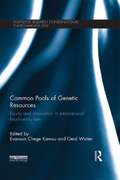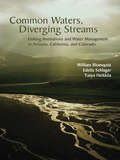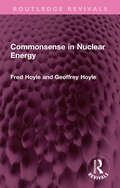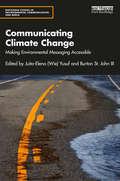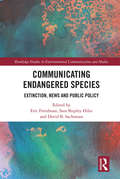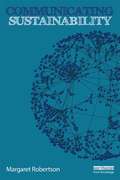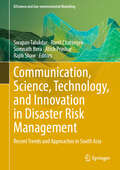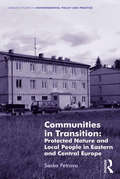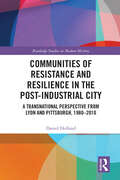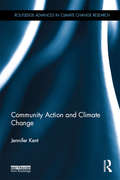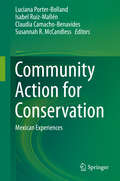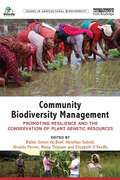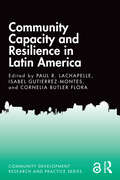- Table View
- List View
Common Pools of Genetic Resources: Equity and Innovation in International Biodiversity Law (Routledge Research in International Environmental Law)
by Gerd Winter Evanson Chege KamauThe Convention on Biological Diversity (CBD) strives for the sustainable and equitable utilization of genetic resources, with the ultimate goal of conserving biodiversity. The CBD and the Nagoya Protocol which has since been elaborated suggest a bilateral model for access to genetic resources and the sharing of benefits from their utilization. There is concern that the bilateral exchange "genetic resource for benefit sharing" could have disappointing results because providers are left out of the process of research and development, benefits are difficult to be traced to sources, and providers owning the same resource may complain of being excluded from benefit sharing. Thus, the CBD objective of full utilization and equitability may become flawed. Common Pools of Genetic Resources: Equity and Innovation in International Biodiversity Law suggests common pools as a complementary approach to bilateralism. This is one of the first books to reply to a number of complex legal questions related to the interpretation and implementation of the Nagoya Protocol. Taking an inductive approach, it describes existing pools and analyzes how they are organized and how they perform in terms of joint R&D and benefit sharing. It presents case studies of the most characteristic types of common pools, provides suggestions for further developing existing pools to cope with the requirements of the CBD and NP and, at the same time uses the clauses these conventions contain to open up for commons approaches. Written by a team of expert academics and practitioners in the field, this innovative book makes a timely and valuable contribution to academic and policy debates in international environmental law, international biodiversity law, intellectual property law, climate law and the law of indigenous populations.
Common Sense in Environmental Management: Thinking Through English Land and Water (Routledge Explorations in Environmental Studies)
by Jonathan WoolleyCommon Sense in Environmental Management examines common sense not in theory, but in practice. Jonathan Woolley argues that common sense as a concept is rooted in English experiences of landscape and land management and examines it ethnographically - unveiling common sense as key to understanding how British nature and public life are transforming in the present day. Common sense encourages English people to tacitly assume that the management of land and other resources should organically converge on a consensus that yields self-evident, practical results. Furthermore, the English then tend to assume that their own position reflects that consensus. Other stakeholders are not seen as having legitimate but distinct expertise and interests – but are rather viewed as being stupid and/or immoral, for ignoring self-evident, pragmatic truths. Compromise is therefore less likely, and land management practices become entrenched and resistant to innovation and improvement. Through a detailed ethnographic study of the Norfolk Broads, this book explores how environmental policy and land management in rural areas could be more effective if a truly common sense was restored in the way we manage our shared environment. Using academic and lay deployments of common sense as a route into the political economy of rural environments, this book will be of great interest to scholars and students of socio-cultural anthropology, sociology, human geography, cultural studies, social history, and the environmental humanities.
Common Threads
by Sharon KallisDisposing of unwanted natural materials can be expensive and time-consuming, or it can present a tremendous opportunity for creating collaborative eco-art. Invasive-species control, green-waste management, urban gardening, and traditional crafts can all be brought together to strengthen community relationships and foster responsible land stewardship. Simple, easily taught, creative techniques applied with shared purpose become the modern-day equivalent of a barn raising or a quilting bee.Common Threads is a unique guide to engaging community members in communal handwork for the greater good. Sharon Kallis provides a wealth of ideas for: Working with unwanted natural materials, with an emphasis on green waste and invasive species Visualizing projects that celebrate the human element while crafting works of art or environmental remediation Creating opportunities for individuals to connect with nature in a unique, meditative, yet community-oriented wayCombining detailed, step-by-step instructions with tips for successful process and an overview of completed projects, Common Threads is a different kind of weaving book. This inspirational guide is designed to help artists and activists foster community, build empowerment, and develop a do-it-together attitude while planning and implementing works of collaborative eco-art.Sharon Kallis is a Vancouver artist who specializes in working with unwanted natural materials. Involving community in connecting traditional hand techniques with invasive species and garden waste, she creates site-specific installations that become ecological interventions. Her recent projects include The Urban Weaver Project, Aberthau: flax=food+fibre, and working closely with fiber artists, park ecologists, First Nations basket weavers, and others.
Common Waters, Diverging Streams: Linking Institutions and Water Management in Arizona, California, and Colorado
by Tanya Heikkila William Blomquist Edella SchlagerThis book is a firsthand investigation into water management in a fast-growing region of the arid American West. It presents three states that have adopted the conjunctive management of groundwater and surface water to make resources go further in serving people and the environment. Yet conjunctive management has followed a different history, been practiced differently, and produced different outcomes in each state. The authors question why different results have emerged from neighbors trying to solve similar problems with the same policy reform. Common Waters, Diverging Streams makes several important contributions to policy literature and policymaking. The first book on conjunctive water management, it describes how the policy came into existence, how it is practiced, what it does and does not accomplish, and how institutional arrangements affect its application. A second contribution is the book's clear and persuasive links between institutions and policy outcomes. Scholars often declare that institutions matter, but few articles or books provide an explicit case study of how policy linkages work in actual practice. In contrast, Blomquist, Schlager, and Heikkila show how diverging courses in conjunctive water management can be explained by state laws and regulations, legal doctrines, the organizations governing and managing water supplies, and the division of authority between state and local government. Not only do these institutional structures make conjunctive management easier or harder to achieve, but they influence the kinds of problems people try to solve and the purposes for which they attempt conjunctive management.
Common Wealth: Economics for a Crowded Planet
by Jeffrey D. SachsA set of practical solutions based on a new economic paradigm for our crowded planet, from an assessment of the environmental degradation, rapid population growth, and extreme poverty that threaten global peace and prosperity
Common Wealth: Economics for a Crowded Planet
by Jeffrey D. SachsThis is a book about how we should address the great, and interconnected, global challenges of the twenty-first century. Our task, Sachs argues, is to achieve truly sustainable development, by which he means finding a global course which enables the world to benefit from the spread of prosperity while ensuring that we don't destroy the eco-systems which keep us alive and our place in nature which helps sustain our values. How do we move forward together, benefitting from our increasing technological mastery, avoiding the terrible dangers of climate change, mass famines, violent conflicts, population explosions in some parts of the world and collapses in others, and world-wide pandemic diseases? In answering these questions, Sachs shows that there are different ways of managing the world's technology, resources and politics from those currently being followed, and that it should be possible to adopt policies which reflect long-term and co-operative thinking instead of, as currently, disregard for others and ever-increasing barriers to solving the problems which we collectively face. It is a book which appeals equally to both head and heart, and one which no globally thinking person can ignore.
Commonsense in Nuclear Energy (Routledge Revivals)
by Fred Hoyle Geoffrey HoyleOriginally published in 1979, written at a time when the world stood on the brink of (another) energy crisis, this book argued that an alternative primary fuel had to be found and that the answer lay in the exploitation of nuclear fission. The book sought to dispel the anxieties of environmentalists by correcting what the authors felt were basic misconceptions about nuclear energy. The book distinguishes carefully between nuclear energy and nuclear explosions, as the authors believed that it was the confusion between these two very different things which lies at the root of most opposition to nuclear energy. The Relevant facts concerning nuclear energy are presented in a straightforward way and the case made that nuclear energy can be clean and safe. The book includes a discussion of the storage of nuclear waste and the safety record of the nuclear industry.
Communicating Climate Change Information for Decision-Making (Springer Climate)
by Silvia Serrao-Neumann Anne Coudrain Liese CoulterThis book provides important insight on a range of issues focused on three themes; what new climate change information is being developed, how that knowledge is communicated and how it can be usefully applied across international, regional and local scales. There is increasing international investment and interest to develop and communicate updated climate change information to promote effective action. As change accelerates and planetary boundaries are crossed this information becomes particularly relevant to guide decisions and support both proactive adaptation and mitigation strategies. Developing new information addresses innovations in producing interdisciplinary climate change knowledge and overcoming issues of data quality, access and availability. This book examines effective information systems to guide decision-making for immediate and future action. Cases studies in developed and developing countries illustrate how climate change information promotes immediate and future actions across a range of sectors.
Communicating Climate Change: A Guide for Educators (Cornell Series in Environmental Education)
by Marianne E. Krasny Anne K. Armstrong Jonathon P. SchuldtEnvironmental educators face a formidable challenge when they approach climate change due to the complexity of the science and of the political and cultural contexts in which people live. There is a clear consensus among climate scientists that climate change is already occurring as a result of human activities, but high levels of climate change awareness and growing levels of concern have not translated into meaningful action. Communicating Climate Change provides environmental educators with an understanding of how their audiences engage with climate change information as well as with concrete, empirically tested communication tools they can use to enhance their climate change program.Starting with the basics of climate science and climate change public opinion, Armstrong, Krasny, and Schuldt synthesize research from environmental psychology and climate change communication, weaving in examples of environmental education applications throughout this practical book. Each chapter covers a separate topic, from how environmental psychology explains the complex ways in which people interact with climate change information to communication strategies with a focus on framing, metaphors, and messengers. This broad set of topics will aid educators in formulating program language for their classrooms at all levels. Communicating Climate Change uses fictional vignettes of climate change education programs and true stories from climate change educators working in the field to illustrate the possibilities of applying research to practice. Armstrong et al, ably demonstrate that environmental education is an important player in fostering positive climate change dialogue and subsequent climate change action.Thanks to generous funding from Cornell University, the ebook editions of this book are available as Open Access from Cornell Open (cornellopen.org) and other Open Access repositories.
Communicating Climate Change: Making Environmental Messaging Accessible (Routledge Studies in Environmental Communication and Media)
by Juita-Elena Wie Yusuf And Burton St. John IIIThis edited collection focuses on theoretical and applied research-based observations concerning how experts, advocates, and institutions make climate change information accessible to different audiences. Communicating Climate Change concentrates on three key elements of climate change communication – access, relevance, and understandability – to provide an overview of how these aspects allow multiple groups of stakeholders to act on climate-related information to build resilience. Featuring contributions from a wide range of scholars from across different disciplines, this book explores a multitude of different scenarios and communication methods, including social media; public opinion surveys; participatory mapping; and video. Overall, climate change communication is addressed from three different perspectives: communicating with the public; communicating for stakeholder engagement; and organizational, institutional, risk, and disaster communication. With each chapter focusing on implications and applications for practice, this book will be of great interest to students and researchers of climate change and environmental communication, as well as practitioners interested in understanding how to better engage stakeholders through climate change-related communication.
Communicating Climate Change: The Path Forward (Palgrave Studies in Media and Environmental Communication)
by Susanna PriestThis book asks and answers the question of what communication research and other social sciences can offer that will help the global community to address climate change by identifying the conditions that can persuade audiences and encourage collective action on climate. While scientists often expect that teaching people the scientific facts will change their minds about climate change, closer analysis suggests this is not always the case. Communication scholars are pursuing other ideas based on what we know about influence and persuasion, but this approach does not provide complete answers either. Some misconceptions can be corrected by education, and some messages will be more powerful than others. The advent of the Internet also makes vast stores of information readily available. But audiences still process this information through different filters, based on their own values and beliefs - including their understanding of how science works. In between momentous events, media coverage of climate tends to recede and individuals turn their attention back to their daily lives. Yet there is a path forward: Climate change is a social justice issue that no individual - and no nation - can solve on their own. A different sort of communication effort can help.
Communicating Endangered Species: Extinction, News and Public Policy (Routledge Studies in Environmental Communication and Media)
by Eric Freedman; Sara Shipley Hiles; David B. SachsmanCommunicating Endangered Species: Extinction, News, and Public Policy is a multidisciplinary environmental communication book that takes a distinctive approach by connecting how media and culture depict and explain endangered species with how policymakers and natural resource managers can or do respond to these challenges in practical terms. Extinction isn’t new. However, the pace of extinction is accelerating globally. The International Union for Conservation of Nature classifies more than 26,000 species as threatened. The causes are many, including climate change, overdevelopment, human exploitation, disease, overhunting, habitat destruction, and predators. The willingness and the ability of ordinary people, governments, scientists, nongovernmental organizations, and businesses to slow this deeply disturbing acceleration are uncertain. Meanwhile, researchers around the world are laboring to better understand and communicate the possibility and implications of extinctions and to discover effective tools and public policies to combat the threats to species survival. This book presents a history of news coverage of endangered species around the world, examining how and why journalists and other communicators wrote what they did, how attitudes have changed, and why they have changed. It draws on the latest research by chapter authors who are a mix of social scientists, communication experts, and natural scientists. Each chapter includes a mass media and/or cultural aspect. This book will be essential reading for students, natural resource managers, government officials, environmental activists, and academics interested in conservation and biodiversity, environmental communication and journalism, and public policy.
Communicating Environmental Patriotism: A Rhetorical History of the American Environmental Movement (Routledge Explorations in Environmental Studies)
by Anne Marie ToddEnvironmental patriotism, the belief that the national environment defines a country’s greatness, is a significant strand in twentieth century American environmentalism. This book is the first to explore the history of environmental patriotism in America through the intriguing stories of environmental patriots and the rhetoric of their speeches and propaganda, The See America First movement began in 1906 with the aim of protecting and promoting the landscapes of the American West. In 1908, Gifford Pinchot and President Theodore Roosevelt hosted the White House Conservation Conference to promote the wise use of natural resources for generations of Americans. In 1912, Pittsburgh’s smoke investigation condemned the effects of coal smoke on the city’s environment. In World War II, a massive propaganda effort mobilized millions of Americans to plant victory gardens to save resources for the war abroad. While these may not seem like crucial moments for the American environmental movement, this new history of American environmentalism shows that they are linked by patriotism. The book offers a provoking critique of environmentalists’ communication strategies and suggests patriotism as a persuasive hook for new ways to make environmental issues a national priority. This original research should be of interest to scholars of environmental communication, environmental history, American history and environmental philosophy.
Communicating Sustainability: Making Sustainability Legible
by Margaret RobertsonCommunicating Sustainability is a book of evidence-based strategies for making sustainability vivid, accessible, and comprehensible. To do this, it brings together research from a range of specialties including cognitive psychology, visual perception, communication studies, environmental design, interpretive exhibit design, interpretive signage, wayfinding, storytelling, courtroom litigation, information graphics, and graphic design to illustrate not only what approaches are effective but why they work as they do. The topic of sustainability is vast and complex. It interconnects multiple dimensions of human culture and the biosphere and involves a myriad of systems and processes, many of which are too large, too small, too fast, or too slow to see. Many people find verbal explanations about all of this too abstract or too complicated to understand, and for most people the concepts of sustainability are regarded as quirky, peripheral, and not essential to everyday life. Yet the challenges of sustainability concern the very survival of most species of life on Earth, including the human species. In order for life as we know it to survive and thrive into the future, sustainability must become broadly understood—by everyone, not just activists or specialists. This book offers tools to help make complex systems and nuanced, abstract ideas concrete and comprehensible to the broadest range of people. The goal of communication, and of this book, is to build understanding.
Communication Skills for Conservation Professionals
by Susan Kay JacobsonWhether you are managing wetlands, protecting endangered species, or restoring ecosystems, you need to be able to communicate effectively in order to solve conservation and resource management problems. Communication Skills for Conservation Professionals can help you do just that--it is a practical and inspiring book that provides user-friendly guidance on achieving conservation goals through effective communication. Following introductory chapters that draw on research from communication, psychology, sociology, and education to highlight elements critical for effective communication, the book describes how to gather background information and target audiences, explains how public relations can influence attitudes and behaviors, and outlines how to design and conduct a communications campaign. In addition, it provides step-by-step guidance for using print, broadcast, and electronic mass media; demonstrates methods for developing public talks, interpretive brochures, exhibits, and trails; and explores long-term conservation education strategies for students and adults. This second edition of a widely praised book, originally published in 1999, includes new material on working with stakeholders, volunteers, and other groups to multiply conservation success. It also expands on the use of electronic media with examples of conservation Web pages, blogs, e-newsletters, and other new media. The book's citations have been updated to include a host of Web sites and other electronic sources useful for planning and implementing communication programs. Communication Skills for Conservation Professionals is a valuable addition to the conservationist's toolbox that will help scientists, managers, concerned citizens, and students communicate more effectively.
Communication, Science, Technology, and Innovation in Disaster Risk Management: Recent Trends and Approaches in South Asia (GIScience and Geo-environmental Modelling)
by Rajib Shaw Swapan Talukdar Somnath Bera Atish Prashar Ranit ChatterjeeThis book presents the three pillars of Disaster Risk Management (DRM): communication, innovation, and science and technology. These three pillars are applied across five dimensions, namely risk identification and reduction, preparedness, financial protection, resilient recovery, and risk-informed investments in South Asia. In the coming decades, the region will experience rapid economic development and population growth, which, combined with the effects of climate change, will increase the likelihood of being affected by hazards. As hazards can negatively impact every sector of the economy and undo years of economic progress, effective measures to reduce the risk must be incorporated into development plans and poverty reduction strategies. Technological advances have opened up previously unimaginable opportunities to strengthen resilience and improve communications. In the South Asia, it has been experienced that the prevention of hazards and the development of emergency plans enabled by advances in communications and space technology can be much more successful and significantly costly effective than in the past. The use of space technology in disaster monitoring, early warning, and emergency response and for response has shown remarkable efficiency. New approaches to Disaster Risk Management (DRM) are becoming more available due to recent advances in space and communication technology. This book focuses on the use and innovation of space technology and communication for DRM in two specific areas: the Early Warning System (EWS) and the Disaster Information Management System (DIMS).
Communities Surviving Migration: Village Governance, Environment and Cultural Survival in Indigenous Mexico (Routledge Studies in Environmental Migration, Displacement and Resettlement)
by James P. Robson Dan Klooster Jorge Hernández-DíazOut-migration might decrease the pressure of population on the environment, but what happens to the communities that manage the local environment when they are weakened by the absence of their members? In an era where community-based natural resource management has emerged as a key hope for sustainable development, this is a crucial question. Building on over a decade of empirical work conducted in Oaxaca, Mexico, Communities Surviving Migration identifies how out-migration can impact rural communities in strongholds of biocultural diversity. It reflects on the possibilities of community self-governance and survival in the likely future of limited additional migration and steady – but low – rural populations, and what different scenarios imply for environmental governance and biodiversity conservation. In this way, the book adds a critical cultural component to the understanding of migration-environment linkages, specifically with respect to environmental change in migrant-sending regions. Responding to the call for more detailed analyses and reporting on migration and environmental change, especially in contexts where rural communities, livelihoods and biodiversity are interconnected, this volume will be of interest to students and scholars of environmental migration, development studies, population geography, and Latin American studies.
Communities and Museums in the 21st Century: Shared Histories and Climate Action (ICOM Advances in Museum Research)
by Karen BrownCommunities and Museums in the 21st Century brings together innovative, multidisciplinary perspectives on contemporary museology and participatory museum practice that contribute to wider debates on museum communities, heritage, and sustainability. Set within the context of globalisation and decolonisation, this book draws upon bi-regional research that will enrich our understanding of the complex relationships between Europe, Latin America and the Caribbean through museum studies and practice. Chapters reflect upon the role of museums in defining community identities; the importance of young people’s participation and intergenerational work for sustainability; the role of museums in local development; and community-based museums and climate change. Contributors examine these issues through the lens of museum partnerships and practices, as well as testing the continued relevance of the notion of ‘integral museum’ and its relatives in the form of ecomuseums. With its focus on regional museums in Latin America and Caribbean, this book highlights how the case studies promote greater intercultural dialogue, global understanding and social cohesion. It also demonstrates how the methodology can be adapted to other communities who are facing the perils of climate change and unsustainable forms of development. Communities and Museums in the 21st Century proposes creative and sustainable strategies relevant to a globalised future. With its focus on global societal challenges, this book will appeal to museologists and museum practitioners, as well as those working in heritage studies, cultural studies, memory studies, art history, gender studies, and sustainable development.
Communities in Transition: Protected Nature And Local People In Eastern And Central Europe (Routledge Studies in Environmental Policy and Practice)
by Saska PetrovaThe role of local people in contemporary nature conservation practices is often poorly understood or neglected. This book, therefore, examines questions of local participation at the nature-society nexus within national parks in the transitional context of Central and Eastern Europe (CEE). The post-1990 reconfiguration of conservation paradigms in this part of the world has re-opened various age-old debates about the protection and administration of natural heritage. Further complicating the situation has been the introduction of market-based principles, which has embedded the entire process in broader dynamics of neoliberalization and the capitalist space economy. Providing an integrated perspective on why, how and for whom nature conservation practices have been implemented in CEE, this book sheds further light upon the mechanisms through which such practices both redefine and are affected by the everyday life of people living in national parks. Offering a critical global review of the environmental motivations and power interests behind the creation of national parks, as well as a typology of the relations between local people and the dynamics of nature protection in them, this work challenges the dichotomy between developed and developing countries that pervades much of the academic literature on nature protection. Author Saska Petrova highlights the lessons that can be learnt by applying the experiences of local community participation in environmental management in CEE to other locations undergoing major systemic change in their environmental governance practices, such as the 'low carbon transition' that is currently unfolding at a global scale.
Communities of Resistance and Resilience in the Post-Industrial City: A Transnational Perspective from Lyon and Pittsburgh, 1980–2010 (Routledge Studies in Modern History)
by Daniel HollandThis book is about the grassroots community revitalization movement in Pittsburgh, Pennsylvania, and Lyon, France, between 1980 and 2010, an extension of the post-WWII civil rights campaign that is rarely considered.It tells the story of residents' attempts to improve their communities through social capital or people power. In positive ways, citizens created vibrant, attractive neighborhoods. But their actions also generated unintended consequences, such as high real estate prices and minority displacement that threatened to unravel their hard work. Communities of Resistance and Resilience is an ethnographic survey that relies on oral histories, archival research, on-the-ground site surveys, and the author’s personal experience as a neighborhood reinvestment practitioner for more than 30 years. It brings to life stories that would otherwise remain obscured, such as the lingering impact of the March for Equality and Against Racism, organized in Lyon in 1983, and the formation of the Pittsburgh Community Reinvestment Group in Pittsburgh in 1988, both of which launched national movements.This is of great use to scholars of transatlantic history as well as a general audience interested in modern social movements in the United States and France.
Community Action and Climate Change (Routledge Advances in Climate Change Research)
by Jennifer KentThe failure of recent international negotiations to progress global action on climate change has shifted attention to the emergence of grassroots sustainability initiatives. These civil society networks display the potential to implement social innovation and change processes from the 'bottom up'. Recent scholarship has sought to theorise grassroots community-based low carbon practices in terms of their sustainability transition potential. However there are few empirical examples that demonstrate the factors for success of community-based social innovations in achieving more widespread adoption outside of their local, sustainability 'niche'. The book seeks to address two significant gaps related to grassroots climate action: firstly the continuing dominance of the individualisation of responsibility for climate change action which presupposes that individuals hold both the ability and desire to shift their behaviours and lifestyle choices to align with a low carbon future. Secondly, the potential for community-based collectives to influence mainstream climate change governance, an area significantly under researched. Drawing on empirical research into Australian Climate Action Groups (CAGs) and related international research, the book argues that grassroots community-based collective action on climate change holds the key to broader social change. This book will be of great interest to students and scholars of climate change, citizen participation, environmental sociology and sustainable development.
Community Action for Conservation: Mexican Experiences
by Luciana Porter-Bolland Isabel Ruiz-Mallén Claudia Camacho-Benavides Susannah R. MccandlessThis book provides an in-depth analysis on community conservation in Mexico. The volume explores vivid examples and case studies that illustrate some of the critical issues at stake, including the participation of local communities in national and global conservation, indigenous and local perceptions of conservation initiatives in Southern Mexico, and challenges in ICCA governance and ecotourism. The book also reviews methodological approaches for understanding and strengthening community conservation, touching upon such topics as community-based biodiversity monitoring and tools for understanding children's perceptions of community conservation. Written by international experts in the field, Community Action for Conservation: Mexican Experiences is a lively and deep-running resource that offers invaluable stories and analyses of the Mexican experience with conservation.
Community Adaptation and Vulnerability in Arctic Regions: Framework Document For An International Polar Year Consortium
by Barry Smit Grete K. HovelsrudUnder the auspices of International Polar Year (IPY), the CAVIAR consortium was formed with partners from all eight Arctic countries. The aim of the interdisciplinary CAVIAR project is to increase understanding of the vulnerability of Arctic communities to changing environmental conditions, including climate change, and to contribute to the development of adaptive strategies and policies. In partnership with local collaborators in over two dozen communities, researchers have documented the conditions and forces that contribute to vulnerabilities, identified adaptive strategies and attempted to assess the prospects for adaptation in the future.
Community Biodiversity Management: Promoting resilience and the conservation of plant genetic resources (Issues in Agricultural Biodiversity)
by Walter Simon de Boef Abishkar Subedi Nivaldo Peroni Marja Thijssen Elizabeth O’KeeffeThe conservation and sustainable use of biodiversity are issues that have been high on the policy agenda since the first Earth Summit in Rio in 1992. As part of efforts to implement in situ conservation, a methodology referred to as community biodiversity management (CBM) has been developed by those engaged in this arena. CBM contributes to the empowerment of farming communities to manage their biological resources and make informed decisions on the conservation and use of agrobiodiversity. This book is the first to set out a clear overview of CBM as a methodology for meeting socio-environmental changes. CBM is shown to be a key strategy that promotes community resilience, and contributes to the conservation of plant genetic resources. The authors present the underlying concepts and theories of CBM as well as its methodology and practices, and introduce case studies primarily from Brazil, Ethiopia, France, India, and Nepal. Contributors include farmers, leaders of farmers’ organizations, professionals from conservation and development organizations, students and scientists. The book offers inspiration to all those involved in the conservation and use of agrobiodiversity within livelihood development and presents ideas for the implementation of farmers’ rights. The wide collection of experiences illustrates the efforts made by communities throughout the world to cope with change while using diversity and engaging in learning processes. It links these grassroots efforts with debates in policy arenas as a means to respond to the unpredictable changes, such as climate change, that communities face in sustaining their livelihoods.
Community Capacity and Resilience in Latin America (Community Development Research and Practice Series)
by Cornelia Butler Flora Paul R. Lachapelle Isabel Gutierrez-MontesCommunity Capacity and Resilience in Latin America addresses the role of communities in building their capacity to increase resiliency and carry out rural development strategies in Latin America. Resiliency in a community sense is associated with an ability to address stress and respond to shock while obtaining participatory engagement in community assessment, planning and outcome. Although the political contexts for community development have changed dramatically in a number of Latin American countries in recent years, there are growing opportunities and examples of communities working together to address common problems and improve collective quality of life. This book links scholarship that highlights community development praxis using new frameworks to understand the potential for community capacity and resiliency. By rejecting old linear models of development, based on technology transfer and diffusion of technology, many communities in Latin America have built capacity of their capital assets to become more resilient and adapt positively to change. This book is an essential resource for academics and practitioners of rural development, demonstrating that there is much we can learn from the skills of self-diagnosis and building on existing assets to enhance community capitals. Chapter 3 of this book is freely available as a downloadable Open Access PDF at http://www.taylorfrancis.com under a Creative Commons Attribution (CC-BY) 4.0 license.
